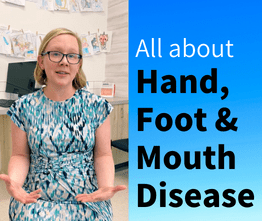Pediatric Dermatologist, Dr. Lisa Swanson at Ada West Dermatology discusses hand, foot, and mouth (HFMD) in children and adults. She covers everything from how the coxsackievirus has changed over the years, the treatment, spread, and complications of rashes for you and/or your child.
Watch the video or read the questions and transcript below.
What is Hand, Foot, and Mouth disease?
Hand, Foot and Mouth Disease is a relatively common rash in children. It’s caused by a virus. There are actually three viruses that can cause hand and mouth. One particular virus called coxsackie. A6 is the most common cause of hand and mouth.
It’s characterized by this widespread rash on the hand, feet and in and around the mouth. And kids with it, they feel sick. They often have a low grade fever, they’re cranky, they just don’t feel like themselves and that makes sense, right? Because it is a viral infection that their immune system is fighting.
Are the Sores Painful?
The sores on the hands and the feet with hand, foot and mouth tend to not be painful. However, sores in the mouth can be very painful. I think the most discomfort kids get from hand, foot and mouth is just the pain of having a virus.
You don’t feel good, achy, perhaps a low grade fever. Maybe you have a little bit of a headache, you just don’t feel good. I think that’s where most of the pain comes from.
Can adults get hand, foot and mouth disease from a child?
So the very interesting thing is that we used to not see hand, foot and mouth in adults prior to maybe six or seven years ago. HFMD was predominantly caused by two different viruses. Coxsackie A 16 and enterovirus 71. And then six or seven years ago, Coxsackie A6 emerged as the primary cause of handphone and mouth. And it’s different in a couple ways. It tends to have pretty aggressive diaper area involvement and a lot of kids will get nail shedding two to three months after having handphone and mouth. The other way that Coxsakie A6 different is that it can affect adults.
There was even a picture for the New York Mets that had to go on the injured reserve list for 10 days because he got hand, foot and mouth. So it is possible for adults to get it.
What is nail shedding (onicomadesis)?
Now there’s this process called onicomadesis that can occur after a HFMD infection. Basically what happens is your nails are growing perfectly normally and then you get sick with hand, foot and mouth and your body decides, “Hey, we have a lot to deal with with this hand, foot and mouth virus. We’re temporarily gonna stop our nails from growing.”
Then you get better and your nails start growing again. But there’s a little bit of a break in between. As the nail grows out, the new nail gets kind of clumped up on the old nail. Eventually the old nail sheds and the new nail grows in behind it. It’s a process called onicomadesis. It’s most commonly triggered by Coxsackie A6. It requires no treatment. Everything will improve just on its own.
Can adults hug and kiss their children with hand, foot and mouth disease?
In my opinion, adults can hug and kiss their child that has hand, foot and mouth. They don’t feel good. They deserve to be cuddled and cuddled. And so I think it’s okay to support them in that way. Could an adult get it? Yeah, they could, but I think still it’s important to, you know, be there for your kiddo when they don’t feel good.
For how long/ when is it contagious?
Hand, foot and mouth is cont is most contagious the first week that you have it, it can take anywhere from 10 to 1 days for it to completely run its course. But the first week that you have it is the most contagious period. So you can even be contagious a day or two prior to the rash appearing, but that’s hard to predict. You don’t know you’re about to get a rash. So by the time you know you have a hand, foot and mouth, the most important time you have to worry about being contagious.
How long should someone with hand, foot, and mouth disease stay away from other people?
As that first week of the rash, I would recommend doing somewhat of a quarantine for that week that you have hand, foot and mouth rash. Your child’s not gonna feel good anyway during that period of time. You’re probably not gonna be going out and doing play dates and things like that cuz your child is gonna feel sick. But also just to protect other people, I would probably stay at home for the first week.
Is there anything that makes a child more susceptible to hand, foot, and mouth disease?
So the interesting thing is that if a child has a history of eczema and then they get HFMD, the eczema and the virus merge to form a super rash called eczema coxsackium. The eczema allows the virus to spread more easily and the virus triggers more eczema. This produces a super rash called eczema coxsackium and it tends to produce a much more impressive rash. Again favoring arms, hands, legs, feet and face. So you can tell it’s hand, foot and mouth, but it looks even more impressive than your regular hand, foot and mouth. So kids with eczema that get hand, foot and mouth, they’re gonna have a tougher course of of illness than kids who don’t have eczema. For eczema coxsackuim, we typically just focus on treating the eczema part of it.
How do you treat HFMD?
So we’ll use some topical medicines that we use to treat the eczema, let the virus run its course and let the child get better.
What is the worst thing you can do for it?
I guess the worst thing you could do for hand and mouth would be to use something potentially abrasive on the skin. The skin is already rashy as a result of the virus, so you certainly wouldn’t wanna put anything on there that’s gonna intensify the potential for irritation. So we use everything soothing things like aquafor or Vaseline, things that are soothing in an ointment base. Nothing too fancy just to avoid any further irritation.
Would you use essential oils for the sores?
My personal opinion would be to steer clear of essential oils for the sores. Essential oils can have ingredients in it that your skin might not like, and then your skin is already inflamed due to this viral infection. And so it would be like putting gasoline on a burn. Your skin might not like it at all, and then it can intensify the discomfort that your child is feeling.








